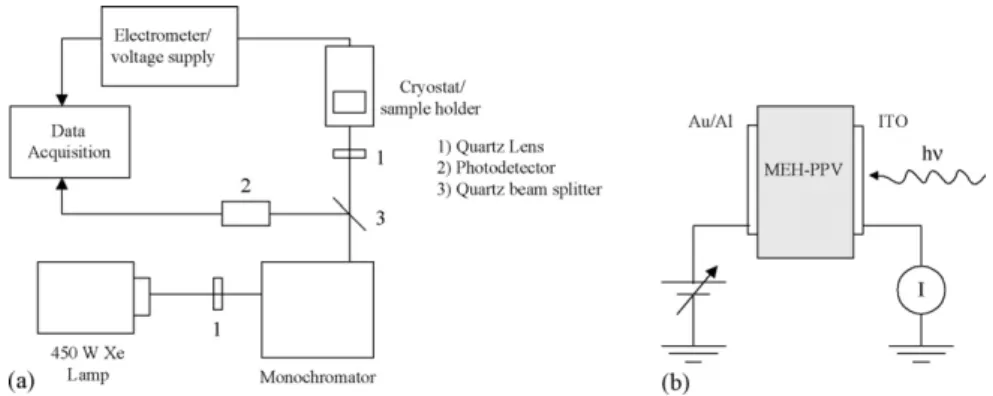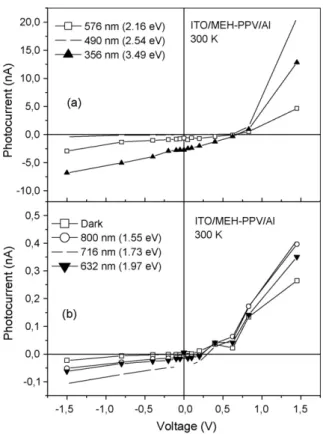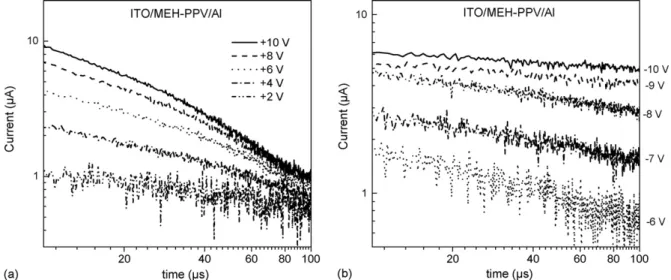Photogenerated carrier profile determination in polymeric light-emitting
diodes by steady-state and transient photocurrent measurements
L.F. Santos
a, R.F. Bianchi
a, R.M. Faria
a, S. Mergulh˜ao
b,∗aInstituto de F´ısica de S˜ao Carlos, Universidade de S˜ao Paulo, CP 369, 13560-970 S˜ao Carlos, SP, Brazil bDepartamento de F´ısica, Universidade Federal de S˜ao Carlos, CP 676, 13565-905 S˜ao Carlos, SP, Brazil
Received 29 July 2005; received in revised form 27 March 2006; accepted 17 August 2006
Abstract
Photogenerated charge carrier profiles in poly(2-methoxy-5-(2′-ethyl-hexyloxy)-1,4-phenylene vinylene) (MEH-PPV) light-emitting diodes were determined from steady-state photocurrent spectra and transient photocurrent decay measurements. The observation that the photocurrent spectra behavior is strongly dependent on the bias polarity and amplitude suggests the existence of an intrinsic electric field, determined by the difference in the work function of the metallic electrodes, as well as a field dependence on the free charge carrier generation rates. The obtained results reveal built-in voltages of +0.2 and−0.6 V for Au and Al electrodes, respectively. The photocurrent spectra can be semi-quantitatively explained using a simple model which takes into account the internal built-in electric field of the device structure, the band gap energy and the migration/diffusion of the photogenerated charge carriers through the polymeric film. The drift mobility of carriers was investigated by the time-of-flight technique (TOF). The value for the mobility of holes was obtained from the change of slopes in the double logarithmic plot of the transient current and was independent of the applied field. The TOF transients for electrons showed no change of slopes in the double logarithmic plot and the drift mobility of electrons could not be calculated.
© 2006 Elsevier B.V. All rights reserved.
Keywords: Polymers; Photoconduction; Mobility
1. Introduction
Conjugated polymers have attracted much attention in the last 15 years due to their semiconducting properties and to their potential application in a wide variety of electronic and opto-electronic devices like light-emitting diodes, photovoltaic cells and field-effect transistors. However, despite the great advance in the development and improvement of new materials and structures, there are still several fundamental aspects related to the excited states in conjugated polymers that are not yet completely understood. One of the most controversial topics discussed in the physics of conjugated polymers is about the nature of the excited states in such materials. In this sense, two opposite positions are generally adopted: one is the tra-ditional semiconductor band model and the other one is based on the formation of bound excited states due to the
molecu-∗Correspondence to: R Luiz Roher, 355, S˜ao Carlos, CEP 13570-002, SP, Brazil. Tel.: +55 16 3351 8223; fax: +55 16 3361 4835.
E-mail address:dsme@df.ufscar.br(S. Mergulh˜ao).
lar character of organic materials. For this reason, photocurrent spectroscopy is a powerful techinique used to study charge car-rier photogeneration and transport in semiconductor devices. Since the photo-excitation generates charged states, which can give rise to a measurable photoconductivity if mobile charge car-riers are produced, the spectral dependence of the photocurrent is frequently used to argue in favor of the band or the excitonic model. In organic molecular solids and highly crystalline con-jugated polymers, there is a large energy difference between the onset of the optical absorption and the onset of the photo-conductivity, which is unquestionably accepted as evidence of the influence of electron–electron interactions in these materials. On the other hand, poly(p-phenylene vinylene)’s (PPV’s) usually present onsets of the photoconductivity and the absorption which are practically coincident[1]. This has been cited as evidence of a semiconducting band model[2–5], with direct photogeneration of free positive and negative carriers, although charge genera-tion is commonly considered as a secondary process, resulting from dissociation of excitons by interaction with defects and impurities in the vicinities of interfaces. Other authors, how-ever, assign this behavior to additional factors[6,7]to develop
detail elsewhere [9]. The average molecular weight of the obtained orange-reddish polymer was 69.000 g mol−1 and the poly-dispersity was about six. The devices were produced by initially etching 14 mm×12 mm ITO-coated glass substrates to give rise to properly designed transparent electrodes. The ITO substrates were further cleaned by rinsing in acetone, rubbing with isopropanol and sonication in dilute aqua regia (HNO2+ HCl) solution for 10 min. After abundantly washing the wafers in de-ionized water and drying with pure nitro-gen, MEH-PPV films (400–800 nm thick) were obtained by spin-casting a 10 mg mL−1 chloroform solution onto the sub-strates. The films were dried in a vacuum at 80◦C for 4 h before vacuum thermal evaporation of the metallic top elec-trodes. Two different non-transparent metallic electrodes (30 nm of Au and 50 nm of Al) with 8 mm2in area were deposited side by side, producing two distinct devices with similar geometric characteristics.
The photocurrent measurements were performed with the devices placed in a nitrogen gas flow cryostat, with transpar-ent quartz windows, to avoid oxidation of the sample. Selec-tive wavelength photo-excitation was performed by focusing onto the sample the light output from a monochromator (Oriel Instruments) used to separate the spectral response of a 450 W Xe lamp. Scanning of the incident light wavelength in the 300–800 nm range was carried out at rates varying from 24 up to 120 nm min−1. Since no variations in the photocurrent spectra were observed in the used scanning rates, the charge separa-tion and transport processes were considered as fast enough
ITO electrode is positively polarized. For the transient current measurements, a pulsed nitrogen laser (Oriel Instruments) was used to generate short pulses (5 ns length) to excite the samples through the ITO electrode. A Coumarine 503 Oriel Dye was used to excite the sample with a 490 nm laser. The current transients were measured using a broadband current amplifier (Stanford Research SR570) coupled to a fast digital oscilloscope (Tek-tronix 340 A), triggered by the laser pulse.
3. Results and discussion
The photocurrent action spectra of ITO/MEH-PPV/Al and ITO/MEH-PPV/Au devices are shown in Fig. 2. The upper graphs show the normalized photocurrent spectra, in comparison with the absorption spectrum of MEH-PPV. The response of the photocurrent action spectrum is usually classified as being of two types: symbatic, if the photocurrent spectrum follows the absorp-tion spectrum and antibatic if the photocurrent spectrum behaves differently of the absorption spectrum, presenting almost com-plementary characters[10]. InFig. 2a, the ITO/MEH-PPV/Al device shows a clear antibatic behavior when short-circuited or negatively biased (Vb=−1.5 V), characterized by a evident sharp peak around 2.2 eV and practically null photocurrent val-ues in the region where the MEH-PPV strongly absorbs, between 2.3 and 2.9 eV. On the other hand, for the device biased posi-tively (Vb= +1.5 V), the photocurrent spectrum visibly switches to a symbatic behavior. For photon energies above 3 eV, the photocurrent increases continuously to the energy upper limit
Fig. 2. Photocurrent spectra of a ITO/MEH-PPV/Al device (a) normalized spectrum, (b) absolute values and a ITO/MEH-PPV/Au device (c) normalized spectrum and (d) absolute values at 300 K for different bias voltages.
attainable by the experimental setup (4.1 eV), regardless the bias polarity.
Fig. 2b shows the voltage dependence of the photocurrent spectra of the ITO/MEH-PPV/Al device. For negative volt-ages, the photocurrent, which always presents a negative value, increases in amplitude with the bias. For positive voltages, the photocurrent still presents negative values, decreasing in ampli-tude with increasing bias from 0 to +0.6 V. Above this voltage, the photocurrent curves switch the polarity and start to present the symbatic behavior described before. Moreover, the onset of the photocurrent in the high energy regime is slightly higher (∼3.5 eV) than observed for negative biases (∼3.1 eV).
For the ITO/MEH-PPV/Au device (Fig. 2c and d) the pho-tocurrent values are almost three orders of magnitude lower than those observed for the ITO/MEH-PPV/Al device. For the device biased positively, the absolute photocurrent decreases from low to high energies, reaching a minimum around 2 eV. For energies higher than 2.2 eV, the photocurrent starts to increase, showing a symbatic behavior in the region where MEH-PPV absorbs well. For energies above 3.5 eV, the photocurrent increases steeply, as already observed for the ITO/MEH-PPV/Al device. For nega-tive voltages, the photocurrent spectrum is practically antibatic in the whole energy range. Differently of the ITO/MEH-PPV/Al device, the device with gold cathode has a short-circuit photocur-rent spectrum similar to those obtained with the device biased positively. For negative bias until−0.4 V, the spectrum is sim-ilar as for short-circuit showing, however, lower photocurrent values. For higher voltages, the minimum in the photocurrent at 2.0 eV still persists but the photocurrent switches to negative values.
The observed results indicate the formation of internal built-in electric fields built-in both kbuilt-ind of devices. Sbuilt-ince the
short-circuit photocurrents present contrary behaviors (negative for the ITO/MEH-PPV/Al and positive for the ITO/MEH-PPV/Au), these electric fields must have opposite directions. These built-in voltages can be roughly estimated by the difference between the ITO and the metallic electrodes work-functions. For the ITO/MEH-PPV/Al device, this voltage (Vb=(φAl−φITO)/e) should vary from −0.3 to −0.7 V (φITO= 4.6 – 4.8 eV and φAl= 4.1 – 4.3 eV) whereas, for the ITO/MEH-PPV/Au device, it should be between +0.2 and +0.6 V (φAu= 5.0 – 5.2 eV).
The built-in voltage can be better observed analyzing the dc current–voltage (I–V) curves obtained at different wavelengths as shown inFigs. 3 and 4.
As commonly observed in such structures, the Al device in the dark presents a rectifying behavior due to the expected bet-ter hole injection from ITO into the polymer. Under illumination at energies which do not present strong photocurrent spectrum (Fig. 3b), little variation occurs in theI–Vcurve. For energies which present higher photocurrent spectra (Fig. 3a), a clear photovoltaic effect can be observed. Although the short-circuit current (Isc) varies with the photon energy, the open-circuit volt-age (Voc) is almost energy independent (about +0.6 V). The open-circuit voltage can be interpreted as the voltage required to overcome the built-in voltage (Vb) which, in this case, is−0.6 V, in agreement with the expected value.
Fig. 3.I–Vcurves for the ITO/MEH-PPV/Al device at 300 K for different photon energies (incident flux: 0.65 mW/cm2): (a) 2.16, 2.54 and 3.49 eV and (b) 1.55, 1.73 and 1.97 eV.
In order to explain the symbatic/antibatic behavior of the pho-tocurrent spectra, one can initially use a qualitative explanation based on the charge carrier generation profile, determined by the absorption spectrum, and the transport/diffusion of the free carriers towards the bulk. An appropriate way to determine the nature and the mobility of the major charge carriers is using the time-of-flight technique[11], which is based on the measure-ment of current transients due to fast light pulses.
Fig. 5shows the current transients for the ITO/MEH-PPV/Al device (550 nm thick) for forward (Fig. 5a) and reverse (Fig. 5b)
Fig. 4.I–Vcharacteristics on a ITO/MEH-PPV/Au device for different photon energies (incident flux: 0.65 mW/cm2).
by the front electrode. The transient photocurrent is dominated by holes, but the “effective thickness” of the sample is about 90% of the sample thickness, so, the mobility may be under estimated. The expected error in the mobility is 10%. At low bias values (below +4 V), the transit time of the charge carriers is too long to be observed in the used time scale, originating long-lasting current decays. For higher biases, the transit time of the carrier can be determined by the change in the slope of the current transient in the log–log plot (Fig. 5a). The calcu-lated hole mobility for this sample is field independent and its mean value is about 4×10−6cm2/(V s). For the ITO polarized negatively, the current transients are expected to be due to neg-ative free charge carriers. In the whole applied bias range (0 to −10 V), no transition in the log–log plot of the current transients could be observed, only the same long current decays observed at low positive voltages. This indicates that the electron mobility is much lower (at least two orders of magnitude) than the hole mobility in MEH-PPV.
Fig. 5. Transient photoconductivity transits for the ITO/MEH-PPV/Al device at 300 K: (a) current dominated by holes and (b) current dominated by electrons.
high positive voltages are applied, the built-in voltage is sur-mounted by the external bias and the observed symbatic behavior is simply explained considering a model in which directly car-rier photogeneration (or weakly bound pairs) occurs. An analog explanation can be used to explain the photocurrent spectrum of the ITO/MEH-PPV/Au device.
4. Conclusions
Photocurrent action spectra were used to observe the exis-tence of built-in voltages in polymeric LEDs which are strongly dependent on the work-function of the metals used as electrodes. The open-circuit voltages observed in theI–Vcurves under illu-mination can be used to determine, for each device, the built-in voltage. Transient current measurements were used to confirm that the mobility of positive photogenerated free charges is much higher than the mobility of the negative ones. This information is valuable in order to explain qualitatively the observed photocur-rent spectra behavior. A more detailed semi-quantitative model is being developed to be published soon elsewhere.
References
[1] R.N. Marks, J.J.M. Halls, D.D.C. Bradley, R.H. Friend, A.B. Holmes, J. Phys. Condens. Matter. 6 (1994) 1379–1394.
[2] C.H. Lee, G. Yu, A.J. Heeger, Phys. Rev. B 47 (1993) 15543– 15553.
[3] X. Wei, M. Raikh, Z.V. Vardeny, Y. Yang, D. Moses, Phys. Rev. B 49 (1994) 17480–17483.
[4] D. Moses, H. Okumoto, D. Comoretto, C.H. Lee, A.J. Heeger, T. Ohnishi, T. Nogushi, Synth. Met. 84 (1997) 539–544.
[5] D. Moses, D. Comoretto, C.H. Lee, A.J. Heeger, Synth. Met. 84 (1997) 559–562.
[6] M.G. Harrison, J. Gr¨uner, G.C.W. Spencer, Phys. Rev. B 55 (1997) 7831–7849.
[7] N. Chawdhurry, A. K¨ohler, M.G. Harrison, D.H. Hwang, A.B. Holmes, R.H. Friend, Synth. Met. 102 (1999) 871–872.
[8] M. Gailberger, B.N. Thanh, H. B¨assler, Mol. Cryst. Liq. Cryst. 217 (1992) 217–221.
[9] F. Wudl, G. Srdanov, US Patent No. 5189136, 233 (1993). [10] H.B. DeVore, Phys. Rev. 102 (1956) 86–91.



